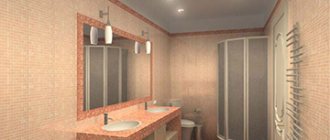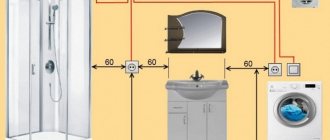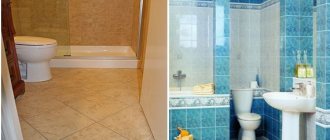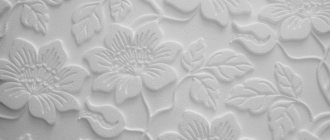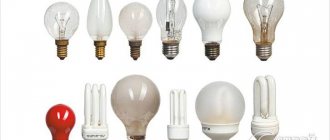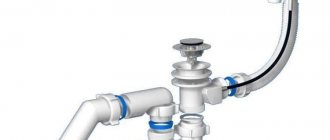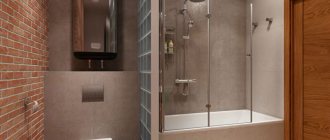There are many options for finishing ceilings in bathrooms and bathrooms - from the simplest to the exclusive. But one of the most popular is the suspended ceiling, which combines practicality, reliability and special decorativeness. Fabrics for tension structures are available in a wide range, to suit every taste and budget. To choose the right suspended ceiling for the bathroom, it is worth studying its characteristics, pros and cons, and installation features in more detail.
Stretch ceiling in the bathroom
Brown stretch ceiling in the bathroom
Types of texture
Of course, it is worth considering the features and size of the room. They directly affect the decor. The suspended ceiling itself can be constructed from different types of PVC film. The following types of textures are available for finishing:
- Gloss. The main feature of this coating is its reflective ability. Therefore, when installing, you need to take this property into account, which will allow you to properly organize the lighting in the bathroom. Correctly selected light sources and properly installed glossy canvas will allow you to decorate even small and low rooms.
Glossy canvas
- Satin. This coating has all the characteristics of gloss and matte. Installation of satin is carried out under wallpaper or painting, therefore it is not recommended for the bathroom. It is best to use light colors, such as pearlescent. The material is velvety, and its light reflection is less intense than gloss.
- Matte canvas. Can be represented by vinyl film or textiles. Typically PVC is used. The coating itself is low in cost, and finishing in this way will appeal to lovers of the classics.
Matte ceiling
Note. If you want to finish in a traditional, restrained style, then preference is given to matte options. An example of the design is in the photo. This solution will create a soft, warm light in the room.
What causes the demand for suspended ceilings?
Installing a stretch ceiling is the fastest way to transform a room. The installation of the selected canvas and the configuration of the tiers takes no more than a few hours. As a result, the owner receives a surface that meets all the requirements for residential and office premises. Its following advantages are undeniable:
- aesthetic appeal;
- modern room design;
- durability.
When asked whether it is possible to install a suspended ceiling in a bathroom, experts give an unequivocal answer: yes. Installers carry out orders for this type of work every day. For the apartment owner, the only difficulty in this matter is the correct choice of canvas . The appearance and durability of the finish depend on this.
Fabric type of covering
The advantages of this material include the following:
- such a solution will allow you to hide all utility networks;
- the material does not fade during prolonged use;
- textile stretch ceiling does not support combustion, although it melts, it does not absorb moisture, but is saturated with odors;
- this material is reminiscent of a velvet screen in a movie theater;
- installation is carried out on slats or steel profiles without heating or stretching.
When installing a fabric product, you need to use proprietary fastening systems. The base is a frame made of wooden slats or steel profiles. The suspended or suspended ceiling itself is installed immediately at the repair site, and not in the workshop, which simplifies the task of transportation. On the other hand, the harpoonless method is not for everyone, especially if you want to carry out the installation yourself. At the same time, this method of fixation limits the dismantling of the suspended ceiling if repairs are necessary - you can unfasten the canvas only on one side.
Fabric construction
Tensile structures made of fabric are environmentally friendly. Therefore, at the beginning of their history, they were mounted on slats in medical institutions and kindergartens. And only after a decade and thanks to complex popularization processes did they find their way into residential buildings. At the same time, many people liked such designs.
A suspended ceiling made of fabric can only conditionally be called seamless. Such variations are installed in rooms up to 5 meters wide. If the room is wider, which is not typical for a bathroom, then installation will require joints. The disadvantage of hanging structures with textiles is the limited choice of colors. Only white and pastel colors are offered.
Finish options
The advantages of the tension system are its wide range and wide range of colors. Therefore, it can take a long time to make a choice. For bathroom design, there are more than 150 gloss tones of the same texture. As a rule, a suspended or suspended ceiling is made several shades lighter than the walls. In this case, the wallpaper must match in tone.
Design example
Color solutions that are recommended for bathrooms:
- White. This is a classic. This method is universal and can be used for any wall decoration with wallpaper. It is appropriate to answer the available white color options:
- chalky;
- snow;
- shade of milk;
- ash color and others.
Which option to choose depends on the lighting solution of the suspension system and the desired design of the room.
- Black. Used as a counterbalance to white. This coating option is used when dark colors are used in the wallpaper and walls. In this case, it is worth taking care of good lighting.
- Red. It harmonizes well with black and creates a bright and creative impression of the hanging structure. But it is worth taking into account that this tone can only be used if the room is large. Otherwise, the situation will simply “pressure”. But in combination with white, on the contrary, it can be used for a small room.
Bathroom in red tones
- Beige tone. Finishing a suspended structure in this color looks cozy if the covering is used in the same color. At the same time, the tiles can be laid in dark beige and even brown tones. This design of a stretch ceiling is associated with chocolate.
Frame selection
The frame part can be made of three types of materials: wood, plastic and metal. A wooden base is unacceptable for a bathroom due to its instability to moisture. After some time, the wood will begin to rot, and even treatment with a moisture-repellent agent does not guarantee that problems can be avoided.
Plastic material tolerates moisture well and is not subject to rotting, but is fragile. Therefore, the frame on plastic will not last long. Most often, the third assembly option is chosen - from a metal profile. This design is durable, safe, easy to install and lasts a long time.
What color and style of suspended ceiling to choose for the bathroom
The advantage of PVC canvases is that it is possible to choose not only a suitable range of colors, but also to order the canvas with almost any texture and pattern. Popular bathroom ceilings are white. They are versatile and can be applied to any interior style. Warm beige ceilings will look more expressive. They look less banal and more comfortable.
Beige room decoration
Also, when decorating a bathroom, blue and light blue canvases are often used. Successfully combined shades of the ceiling and tiles create an interesting “marine” theme. In principle, any color of the canvas can be used. This already depends on the overall desired interior.
When choosing the color and design of the ceiling, in addition to your own taste, you should take into account the following points:
- tile color and pattern;
- shade of the floor and walls;
- what plumbing will be used.
And if difficulties arise with an independent choice, then you can always turn for help to the designers of the company you contacted for the canvas.
But when choosing a stretch ceiling, problems are unlikely to arise. After all, diversity cannot but please.
Ventilation
The personal hygiene room differs from all other rooms of the house in the increased humidity and temperature during its direct use and the urgent need for high-quality ventilation to prevent the appearance and growth of harmful fungal and other organic formations. This also applies to the under-ceiling space hidden behind a suspended ceiling, in which ventilation holes are required.
The technological process of installation and installation of any type of suspended ceilings can be divided into the following stages:
- Preparing the ceiling and sub-ceiling space
- Selection and correct marking of suspended ceiling height
- Installation of the main supporting structure
- Marking and preparation of technological holes for electric lighting and ventilation
- Installation of decorative ceiling elements on a supporting structure
- Checking the operation of lighting devices and technical ventilation
Gold suspended ceiling
Practical properties of the material, rules of operation and care of the ceiling
Knowing the characteristics of PVC fabric will help you make a decision. Now we will talk about them. First of all, it perfectly hides pipes, wiring, floor and wall defects. With such a ceiling, there is no threat of flooding from neighbors above. After all, the canvas is guaranteed to withstand the weight of water and prevent it from entering the room. This means that nothing will happen to the repair. In order to drain the water, it will be enough to make a lapel in some place.
Flooded ceiling
Note: In such a situation, it is not recommended to drain the water yourself. It's better to invite a specialist. After all, without experience, it is easy to damage the canvas.
Glossy ceilings do not fade or change color over time. Therefore, they will have their original appearance even after many years. Unless you want to change the interior and color scheme again.
Another advantage is that the PVC ceiling does not deteriorate at temperatures from 0 to +60 degrees. But you can also find materials that can withstand -30 degrees. At the same time, they do not lose elasticity and firmness.
Moisture is also not a problem for such ceilings. Due to the structure of the material, it is not absorbed into the fabric, and condensation is also impossible.
To care for the ceiling, simply wipe it with a soft cloth and soapy water. Difficult stains are removed using special polishes, which can be found in any hardware store, or with a light solution of ammonia.
Structure care
Installation of hangers
The most difficult task when installing suspended ceiling hangers in a bathroom is considered to be drilling holes in the ceiling, since in most cases these structural elements are made of concrete. Therefore, it is necessary to prepare tools designed specifically for this purpose. In particular we are talking about the following:
- A drill with a special attachment or a hammer drill.
- Screwdriver with battery.
- Drills with pobeditovy tip.
- Hammer.
- Several plastic dowels.
After completing the preparatory activities, you can begin further work. In particular, the question of how to make a ceiling in a room with your own hands is solved in the following sequence:
- Drawing up a diagram of the location of the suspensions, it should be taken into account that the maximum distance between them should be 40 cm.
- In accordance with the diagram for attaching the suspensions, marks are made on the ceiling.
- Using a hammer drill or drill, holes are drilled in the marked places. Their depth should be slightly greater than the length of the selected dowels.
- The dowels are inserted into the prepared holes and hammered.
- To attach the hangers, self-tapping screws are used, which must be screwed into dowels. In this case, the fastening element should be taken a slightly shorter length.
Installation of a tension system in the bathroom
How long does installation take? This question is asked by everyone who wants to install such a structure in their home. This is due to the fact that the work does not generate dust. Installation will not cause destruction or construction waste.
In essence, the installation of a tension structure comes down to the following stages:
- installation of a guide profile or support rail around the perimeter of the room;
- arrangement of electrical wiring cables for organizing light;
- heating the material using a heating unit (gun) and further threading it into baguettes on slats;
- After filling the material into the grooves of the baguettes and effectively fastening the slats, the heat gun is turned off so that the canvas cools and tightens.
After these manipulations, the plane will be perfectly flat and with a drum effect. Further work boils down to the installation of light sources. Most often, spotlights are installed for tension systems.
After carrying out all these processes, you need to cover the wedges with the ceiling plinth. The installation procedure is demonstrated in the video at the end of the article. This will allow you to familiarize yourself with the installation in absentia, successfully complete the device and make the design aesthetically pleasing.
Installation of a stretch ceiling
All work will take 3-4 hours. This is an advantage of tension systems in comparison with a suspended ceiling made of plasterboard, which needs not only to be installed, but also to carry out a whole series of cladding works:
- primer;
- putty;
- painting.
And this adds time and construction waste to the site.
Important! Under no circumstances should a switched-on heat gun be directed at containers containing explosive substances (propane and oxygen cylinders, etc.).
Methods of fastening the canvas
Stretch ceiling fastening systems
Installation of a stretch ceiling can be done in three ways, each of which has its own advantages. The choice of fastening system depends on the financial capabilities of the customer and the skill of the person performing the installation.
Harpoon system
Harpoon mounting system
This is the most modern, convenient and reliable installation method today. A special feature of the fastening system is the presence of a rigid edging around the perimeter of the canvas. The edging is made of plastic or aluminum and is shaped like a hook (harpoon), which gives the installation technology its name. The harpoon can only be welded to PVC film, so other fastening systems are used for fabric ceilings.
Wall plastic profile for harpoon system
Harpoon for suspended ceilings
Installation requires preliminary measurements of the room, and as accurate as possible - the permissible error is 10 mm. They measure not only the perimeter of the bathroom, but also the diagonals, which eliminates the slightest distortions. Calculations are made taking into account the shrinkage of the material, which varies between 5-10% of the total area depending on the type of fabric. All calculations are performed by a special program, and cutting, welding of blades together and soldering of harpoons is carried out on special machines. It is impossible to do this at home, so the future ceiling is delivered ready-made to the installation site.
Installation without gaps and with insert
There are two types of harpoon systems - standard and hidden. The first type implies the presence of a technological gap 4-7 mm wide between the wall and the canvas. After tensioning the film, this gap is closed with a decorative baguette. With the second type of fastening, the canvas is closely adjacent to the wall, so there is no need for camouflage inserts. The main condition for such installation is extremely smooth walls, while for a standard system the curvature of surfaces does not play a role.
Ceiling aluminum profile for harpoon system
Profile for harpoon gapless fastening system for suspended ceilings
The harpoon fastener consists of only two elements - a supporting profile made of plastic or aluminum and a wedge-shaped edging soldered along the edge of the canvas. The installation process is carried out as follows: the supporting profile is screwed with self-tapping screws around the perimeter of the bathroom, the corners of the sheet are fixed in the profile and the hanging film is heated with a heat gun. The canvas becomes pliable and easily stretches between the guides. The harpoon is inserted into the profile slots and pushed inside with a special spatula, after which the fastener automatically snaps into place. The cooled canvas stretches and forms a perfectly flat surface.
Dividing profile for harpoon system
Pros of the harpoon system:
- in case of flooding, the canvas can withstand a weight of up to 100 kg/m2 without detachment from the profile;
- installation takes a minimum of time and is characterized by high quality and durability;
- complete absence of folds, sagging and other defects even after several years of use;
- if necessary, you can perform partial or complete dismantling of the system and reinstallation without reducing performance;
- the ability to install multi-tiered ceilings of any complexity and shape.
Harpoon fastening system is the main one for all PVC ceilings
The only downside is the high cost of such a ceiling and the need for special equipment for installation (heat gun).
Bead system
Bead fastening system
Installation using bead fasteners is the most affordable and suitable for rooms with low ceilings. The distance between the ceilings and the tension fabric does not exceed 15 mm. This system is used for both vinyl and fabric sheets. Unlike the harpoon method, there is no need to pre-cut the canvas: after fixing the edges in the profile, all excess is cut off.
The glazing bead system consists of a U-shaped profile, aluminum or polymer, wooden or plastic glazing bead, and decorative plinth. Before installation, the size of the film should be 10-20 cm larger than the width and length of the bathroom, the shape should be rectangular. The workflow looks like this:
- after securing the U-shaped guides, the edges of the canvas are brought into the profile at the corners and fixed inside with glazing beads;
- the film is heated with a heat gun and installation begins from the short side, pulling the film towards the profile and clamping it with glazing beads;
- Having secured one short edge, proceed to the long ones, carefully adjusting the tension of the film. This point is very important, since uneven stretching will cause displacement of the seams and holes for the lamps;
- The second short edge is fixed last, the excess film is cut off and decorative baguettes are inserted.
Beading method of fastening a stretch ceiling
Installation using a bead
Advantages of the glazing bead system:
- low cost of components and installation;
- saving room height due to the small thickness of the ceiling structure;
- there is no need for precise measurements of the room.
This method has more disadvantages than advantages:
- dismantling the system and reinstalling it is impossible, since when clamped, the glazing beads deform the film. For the same reason, it is impossible to repair individual sections of fasteners if damaged; the entire ceiling will have to be replaced;
- in case of flooding from above, the canvas cannot withstand high loads and can break out of the profiles;
- sagging of the canvas is often observed, which only intensifies over time;
- It is not always possible to achieve uniform stretching, so seams and cutouts may be curved;
- It is not possible to install multi-tiered ceilings.
Wedge system
According to the installation principle, the wedge system resembles the glazing bead system, but it has some differences. A plastic elastic profile is used as guides, which ensures a tight fit even with minor unevenness. The distance from the ceilings is 35 mm. In addition to the guide profile, the system includes a fixing wedge made of plastic or wood and a decorative baguette.
Wedge profile
The installation process is carried out in exactly the same way as with bead fastening: a profile is installed around the perimeter, the canvas is first fixed at the edges, and after heating it is clamped with wedges on the sides. Excess material is cut off, the gap between the wall and the canvas is closed with an insert. Thanks to the special design of wedges and profiles, it is possible to mount the ceiling in 2-3 tiers and give it a shaped shape.
Advantages of the wedge system:
- the wedges do not damage the edges of the canvas, so the fasteners can be partially dismantled for repairs if necessary. If completely dismantled, the canvas can be reinstalled, but only in rooms with a smaller area;
- the elastic profile perfectly masks all the unevenness of the walls;
- the cost of components and installation is less than with the harpoon method.
Minuses:
- sagging is possible due to uneven tension;
- difficulty of fastening in hard-to-reach places;
- The wedge method is more expensive than the glazing bead method;
- installing a ceiling takes more time.
There are other types of fastening the tension fabric:
- clipso
- сerutti.
Wall profile for clip fastening system
Clipso system or baguette-clothespin
Cerutti mounting system
CERUTTI system
